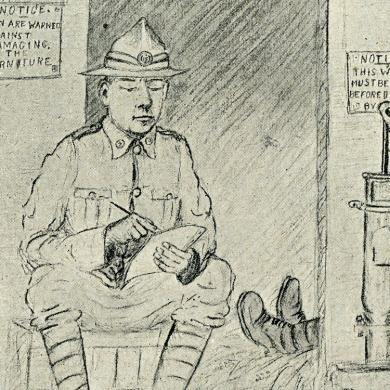How did the New Zealanders’ horrific experiences at Passchendaele change the mood of reporting in the Chronicles of the New Zealand Expeditionary Force?
Readers of the Chronicles in 1916 may have found it difficult to believe the Battle of the Somme was New Zealand’s costliest campaign of the First World War at that time. Accounts of ‘light-hearted and happy’ troops coming back from the field, telling ‘tales … so blithely … of great victory’[1] made no mention of the realities of life and death in the trenches, or the toll the battle would have on New Zealand.
The author of this account was Chronicles editor Clutha Mackenzie, son of New Zealand’s High Commissioner to London, Sir Thomas Mackenzie. In 1914 Sir Thomas had gathered together a group of expatriates to establish the New Zealand War Contingent Association, with the aim of helping New Zealand troops at the front, those convalescing in hospital, and their families. In 1916 the Association published the first issue of the Chronicles, which according to the magazine’s subtitle, were ‘records of matters concerning the troops and gazette of patriotic efforts.’
It is easy to imagine that Mackenzie’s upbeat account of the Somme was written by somebody who had not experienced the realities of war. But in fact, Mackenzie had first-hand experience, having been blinded while fighting at Gallipoli.
Throughout 1916, and in the months leading up to Passchendaele, Mackenzie’s accounts of the war were full of patriotic clichés of noble devotion to duty and sacrifice. After the Somme he wrote in fulsome terms of glorious patriotism and defeat of the enemy, with only brief mention of heavy casualties. Words like splendid, triumphant, heroic, valour and courage were common.
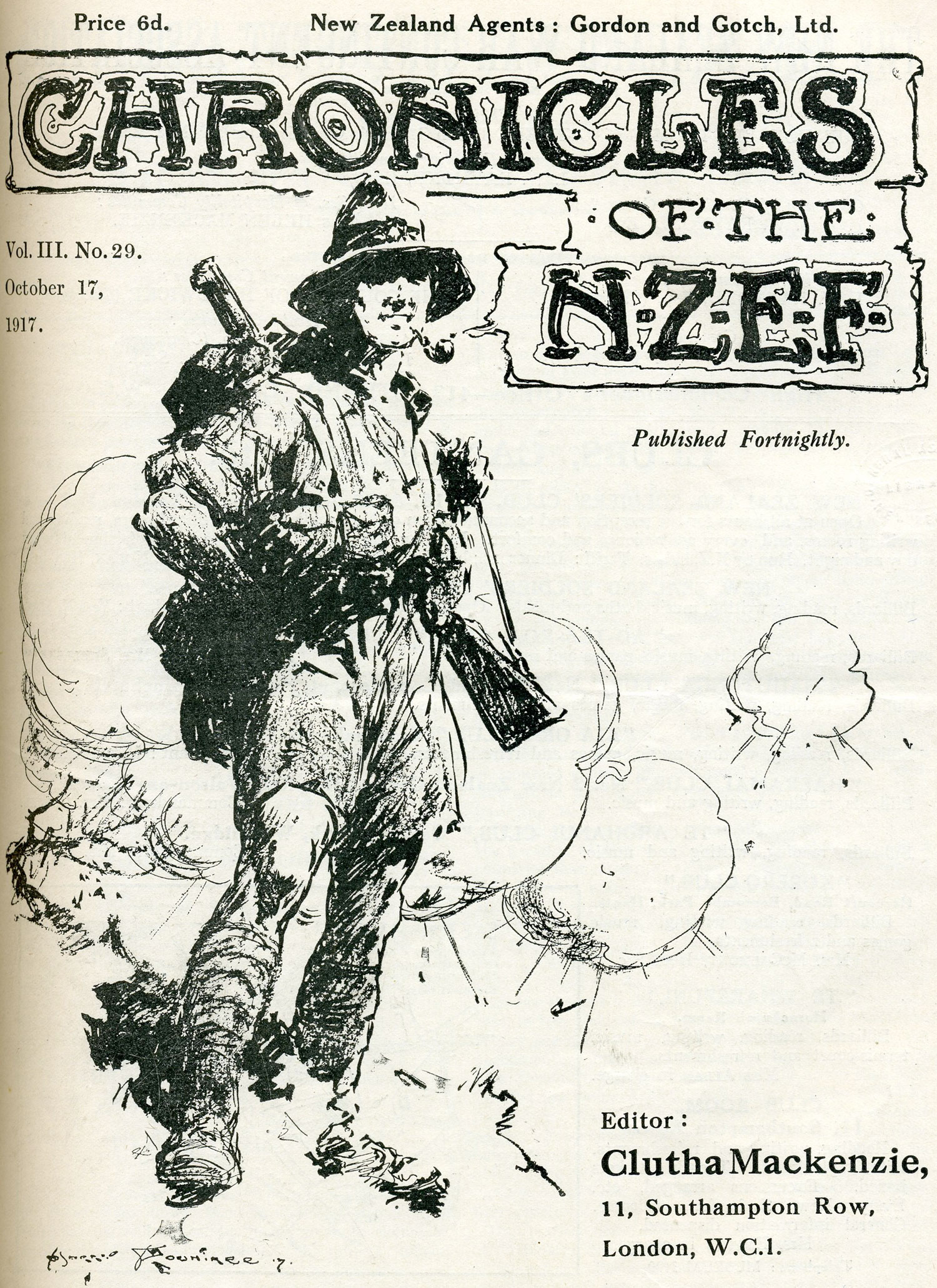
The cover of the troop magazine 'Chronicles of the NZEF', from 17 October 1917, just days after the attack on Passchendaele.
Mackenzie was not alone in his portrayal of the Somme. War correspondent Malcolm Ross wrote mainly of the New Zealanders’ gallantry and heroism with only brief mention of casualties or the appalling conditions. The enemy’s use of tear gas was described as an ‘inconvenience [which is] only temporary.’[2]
Two events of 1917 appear to be instrumental in changing the tone of the Chronicles – the first of which was Mackenzie’s five-month return to New Zealand. While home, Mackenzie followed reports of the war in the local press. Shortly after his return to London he commented,
‘Very little is known about the war, and most people acknowledge and lament their ignorance. The scant cables give little clue to the intensity of the struggle, the communiqués become monotonous with their perpetually ‘successful raids’ at this unknown locality… it is all so distant.[3]
Arguing that people were not properly informed about the war, Mackenzie was determined to publish a more accurate account in the Chronicles.
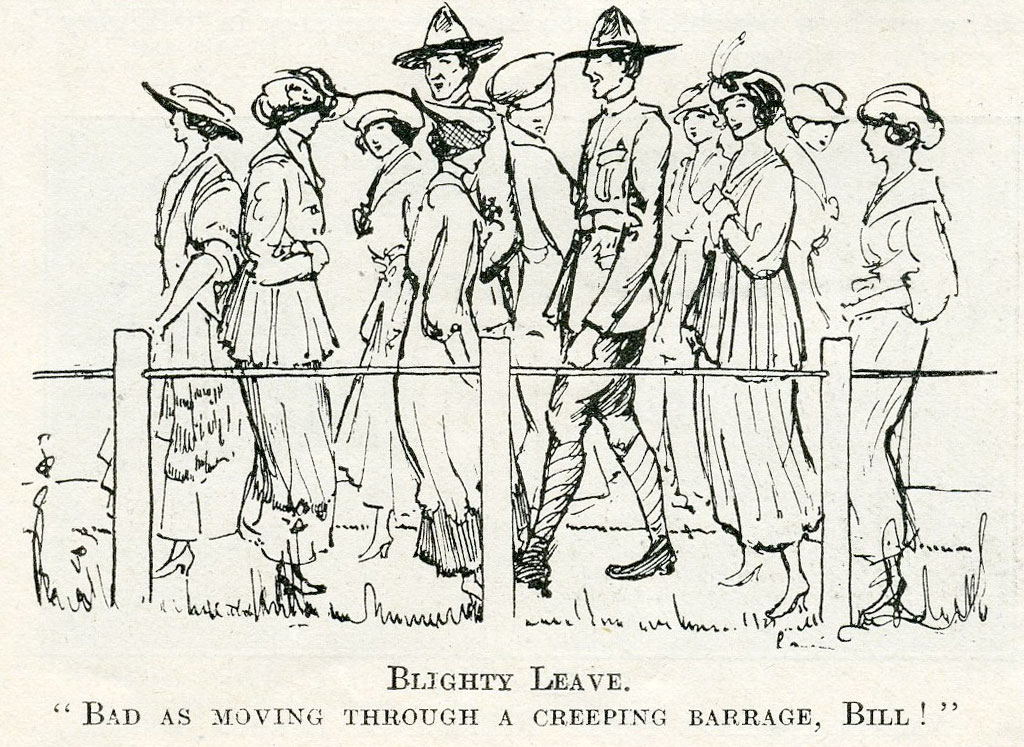
Cartoons like 'Blighty Leave' are indicitive of the good-humoured content that was published in the 'Chronicles', especially before the Battle of Passchendaele. This cartoon was published in Vol. III, No. 26, on 5 September 1917.
The second event was Passchendaele – a disastrous attack by New Zealand troops on Bellevue Spur in mud and relentless rain resulted in more than 3700 casualties, with 843 men killed in a few hours on 12 October alone.
True to his word, Mackenzie began reporting more realistically on Passchendaele, often with brutal honesty. He described the scene,
the enemy’s defence was aided by execrable weather, which made our men’s task humanly impossible. Wet, miserably cold, and with little prospect of success, they did all that mortals could do to gain the German positions … We, here, far away from the Front, are quiet, and stand with bowed heads in deep respect to all the brave fellows who falter under such severe conditions.[4]
Mackenzie’s more harrowing tone was reflected in contributions from war correspondent Malcolm Ross. His earlier flowery prose was replaced by muted tones describing the shock of the experience. Ross wrote,
In the afternoon [of 12 October] the attack was broken off. The walking wounded were struggling back. Mud-stained and blood-stained, some smiling and cheerful, others thoughtful and with wan faces … The infantry fought till they were exhausted, and the stretcher-bearers toiled until they were in the last stages of fatigue … The weariness of the work was beyond description.[5]
Following a visit to the front line, Ross wrote of the ‘torn earth, mud, slush, and brown clayey water. Some of the shell-holes had still a crimson stain. And all about was the litter of war.’[6]
.jpg)
Many of the cartoons in the 'Chronicles' employed dark humour to express the soldiers' frustrations and impending sense of danger. This cartoon by T Kelsey was published in Vol. II, No. 14, on 14 March 1917.
Ross’s more vivid and gruesome descriptions may have been an attempt to counter criticism of his earlier accounts. But they also point to a seemingly more relaxed attitude by the censor to what was published in the Chronicles.
This is significant because the Chronicles had a wider readership than just the New Zealand Expeditionary Force, including a large circulation at home. Its popularity quickly grew from an initial print run of 1,500 copies to circulation figures of 12,000 just 10 weeks later.[7] Readers in New Zealand could subscribe to the magazine or buy it from booksellers.[8] The fact that the Chronicles were widely distributed and popular is important because the reporting in the wider press was increasingly being treated with scepticism.
An article reprinted from the troopship magazine Klink and published in the Chronicles pointed out that the events at Ypres had been misrepresented. The author writes,
When our men were putting up a magnificent fight and holding on with a miserably thin line of soldiers and camp-followers against four, five or six times their number of adversaries, holding on and nothing more, our papers were full of a “great advance in Flanders,” and “notable British victories.”[9]
But it was not just the written accounts which were being viewed more cynically as the war progressed. The whole area of information about what was happening was cause for discontent. A contributor to the Chronicles in January 1918 noted, ‘Lots of old rumours are lifting their heads again over here. … However, when rumours arrive nowadays they don’t get the enthusiastic hearing they did two or three years ago.’[10]
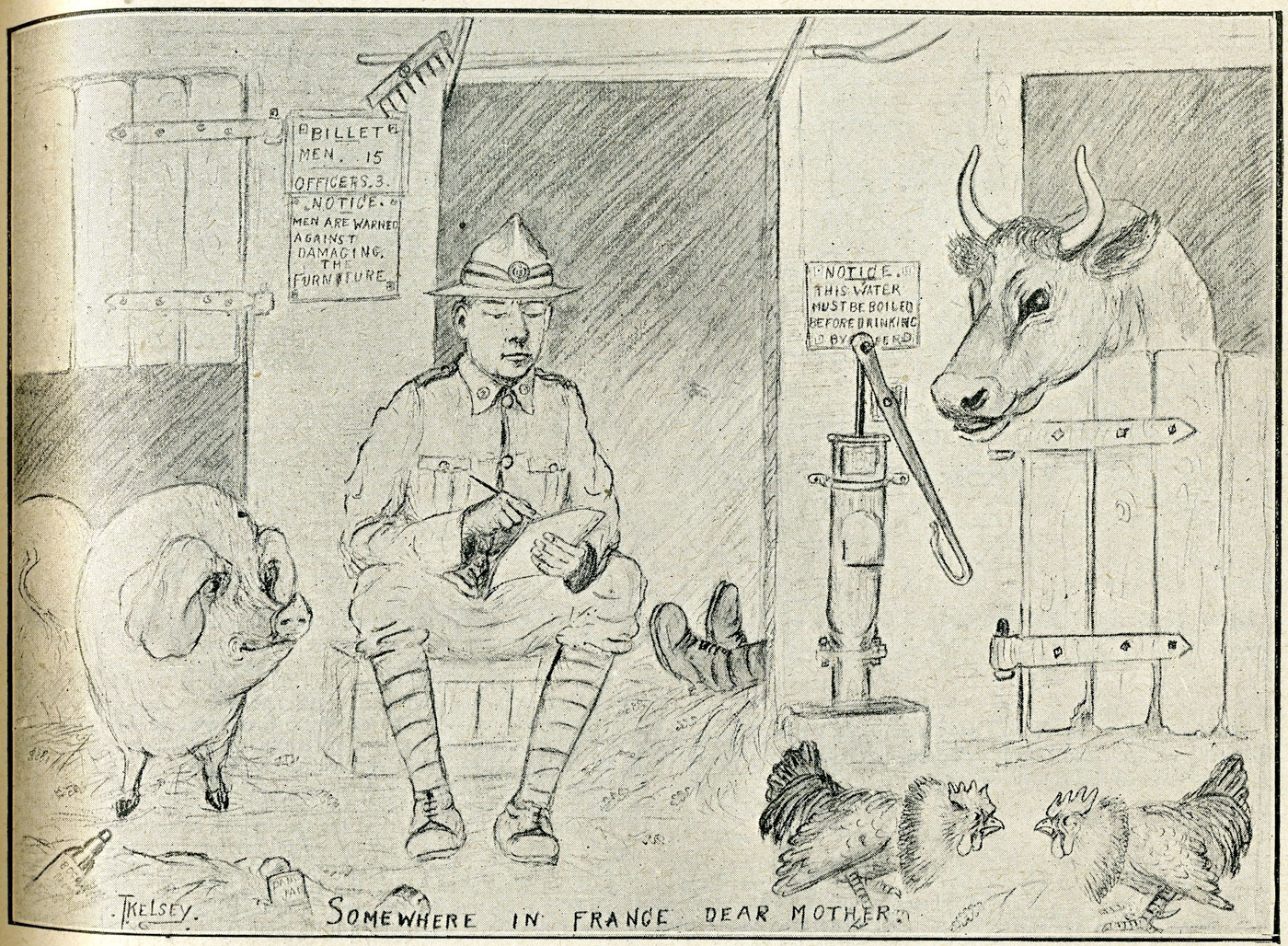
'Somewhere in France', by T Kelsey. Published in the Chronicles Vol. II, No. 17, 2 May 1917.
Always keen to publish first-hand accounts by soldiers, Mackenzie again appealed for ‘more material from the Front itself … about conditions of life, football and other sports, experiences.’[11] Not surprisingly, those accounts, from troops at the front or wounded in hospitals, were often miserable. Describing life in the trenches, one soldier wrote in 1917,
We sit here for month after month in dreary trenches, wet and cold, pelted continually with explosives of every horrible variety, bombed from the air, blown up from underneath, and poisoned by noxious gases … In those first few months of the war, in the far-off days of 1914, there was still a little romance, and we were made merry while it lasted, but it is dead long ago …[12]
Another contributor wrote vividly about Christmas 1917 in the trenches,
None but those who have experienced it can fully understand what a strain on the nerves, what agony it is to crouch in a comparatively shallow trench under heavy shell-fire wondering how long it will be before the shell lands … Under the benign influence of the rum we felt like new men again … We were sleeping (or trying to) in … a two-man dug-out. That is a hole in the side of the trench just large enough to accommodate two men and about thirty rats.[13]
In ‘Ypres Memories’, one of only two poems written in 1917 that specifically names the battle area, there is a description of the terrible conditions
How sweet to tread Track No. 6.
In the teeth of the Easterly wind,
How fondly the Flanders mud sticks –
Like a leech and a lawyer combined.
How nice to slip over the edge
And gently subside in the slime;
And when you grab hold of the ledge
Your mate on your fingers marks time.[14]
By the end of 1917, contributors to the Chronicles were writing frankly about the battlefield conditions, the difficulties encountered and the mood of the men. They acknowledged the feelings of foreboding and portrayed a sense of failure and weariness. Compared to those published in early 1917, the tone of the Chronicles articles following Passchendaele was considerably more muted.
A visit to the front line at Ypres in December 1917 seemed to reinforce to Mackenzie the inaccuracies of earlier reporting. In January 1918 he wrote,
I came back with a fuller realisation than ever of all that the war means and is, and the courage and endurance with which our fellows, no longer assisted by the first romance and joyous enthusiasm of early days, stick the shells, the mud, the rain and all the horrible mechanical devices which science has brought into war. I know too, that we must see that it does not occur again.[15]
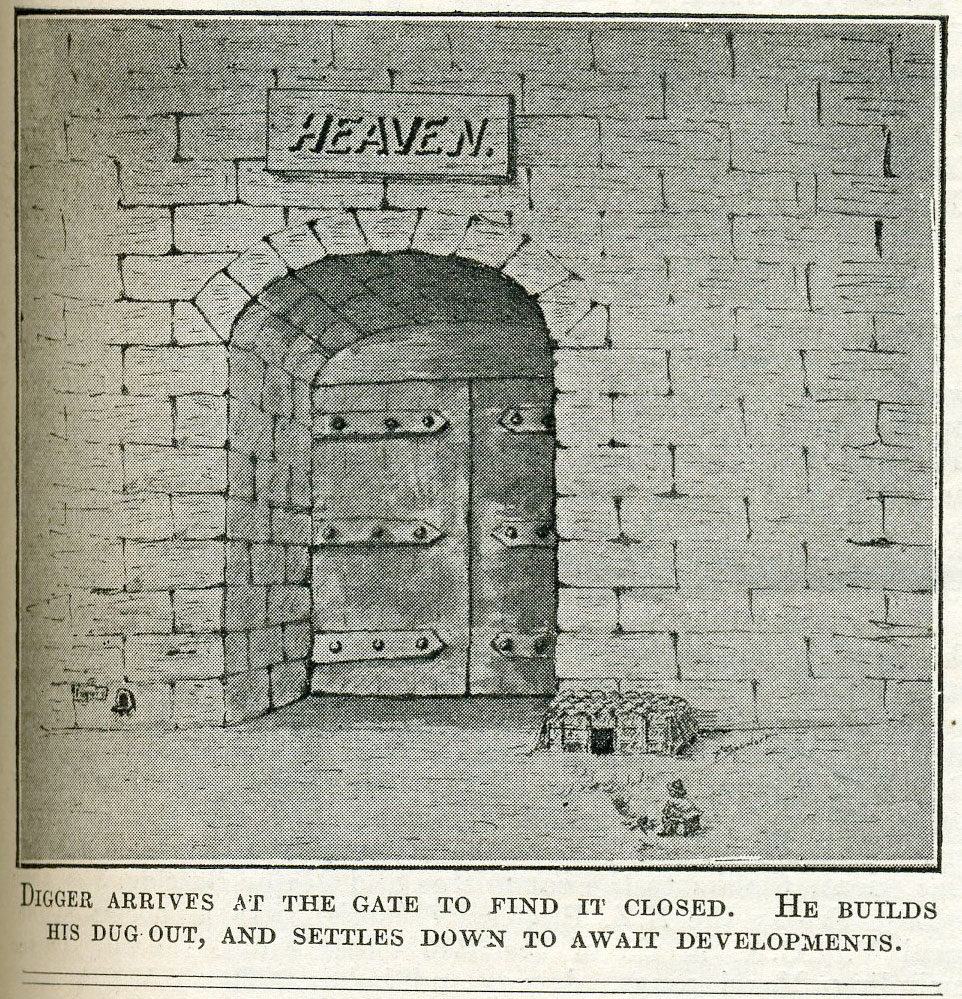
A particularly dark cartoon imagining a soldier's plight in the afterlife was published in the Vol. III, No. 30 issue of the 'Chronicles' on 31 October 1917.
Footnotes
[1] Clutha Mackenzie, ‘New Zealand’s Part in the Somme Battle’, Chronicles of the N.Z.E.F., 1 no. 3 (1916): 51.
[5] Ross, ‘The Terrible Conditions in the Last Battle’, Chronicles of the N.Z.E.F., 3 no. 31 (1917): 153
[13] Goreite, ‘The Joys of Christmas in the Trenches’, Chronicles of the N.Z.E.F., 3 no. 33 (1917): 202.
